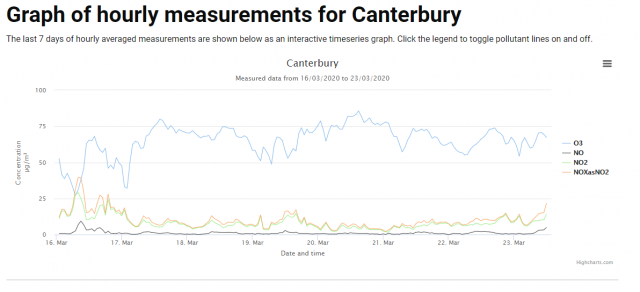› Forums › Atmospheric Phenomena › Huge atmospheric experiment starting
- This topic has 9 replies, 8 voices, and was last updated 5 years, 9 months ago by
 Dawson.
Dawson.
-
AuthorPosts
-
17 March 2020 at 11:40 am #574549
 Alan SnookParticipant
Alan SnookParticipantPleasant observing last night with the intrusive whine of aircraft and their blinking navigation lights much reduced. At dawn this morning there was maybe only half the usual mess of contrails across the Channel. As the European airlines drastically cut their schedules the amount of pollution dumped into the stratosphere will be similarly reduced. It’s going to be fascinating to see the effect. When the Icelandic volcano grounded aircraft for just a few days the difference was quickly noticeable. The current scaling-back is evidently going to last at least ten times longer.
I predict the return of proper blue skies like when I was a lad, and much less of those milky cirriform layer clouds that are so common now. Contrails have a cooling effect so I will also predict a surprisingly warm spring.
Alan Snook
17 March 2020 at 3:20 pm #582111John Cook
ParticipantI have heard that nitrous oxide levels have also decreased dramatically over Italy recently, so perhaps less air pollution too.
17 March 2020 at 7:25 pm #582114 Dr Paul LeylandParticipant
Dr Paul LeylandParticipantI may be wrong but I believe the nitrogen-oxygen compound in the lower atmosphere is NO_2 (nitric oxide for old-timers, nitrogen dioxide for those born in the last fifty years) and not N_2O (nitrous oxide / dinitrogen oxide to the IUPAC fans).
Be that as it may, satellite monitoring has shown a truly dramatic decrease in the concentration of nitrogen oxides in mainland China recently. https://earthobservatory.nasa.gov/images/146362/airborne-nitrogen-dioxide-plummets-over-china has more detail. (Incidentally it supports my claim that NO_2 is the compound in question.)
17 March 2020 at 7:33 pm #582115 Dr Paul LeylandParticipant
Dr Paul LeylandParticipantActually, gaseous NO_2 is in dynamic equilibrium with its dimer N_2_O_4, aka dinitrogen tetroxide. It is the former which has the characteristic brown colour, the dimer being colourless.
I always knew that A-Level chemistry would come in useful one day.
17 March 2020 at 8:41 pm #582116 Peter CarsonParticipant
Peter CarsonParticipantI operate a meteor camera as part of the NEMETODE network. My camera is aimed NE from my home in SE Essex and the main incoming continental air lane crosses it’s field of view.
Because the detection software can’t distinguish between the movement of a meteor and an aircraft I usually get over 200 false detections a night. Last night I got just 25!!It made this morning’s weeding out of false detections much quicker. Can’t think of many advantages of a pandemic but lack of “sky clutter” has got to be one.
Peter
17 March 2020 at 9:54 pm #582117 Nick JamesParticipant
Nick JamesParticipantYes, me too on my meteor cameras. The number of aircraft in the south east of England is falling rapidly. A very small positive amongst a sea of negative. It looks as if we will have several months of this.
17 March 2020 at 11:50 pm #582118 Eric WatkinsParticipant
Eric WatkinsParticipantLikewise Peter, I’m seeing a significant reduction in aeroplane captures on my meteor camera. Can but hope for some improvement in general seeing conditions.
Eric
20 March 2020 at 9:54 am #582124 Alan SnookParticipant
Alan SnookParticipantGood to see the scale of the reduction in the hard data from the meteor cameras noted above. I just tried Flightradar24 but there’s something amiss, the map appears but no aircraft at all, yet I can hear one overhead. Maybe the site is swamped by the at-home cautionary-quarantiners looking for amusement.
20 March 2020 at 12:08 pm #582125 Roy HughesParticipant
Roy HughesParticipantThey’re all at Heathrow.
Flightradar24 is showing a reasonable but not large amount of activity in the SE right now with a massive pileup at LHR 🙂
23 March 2020 at 1:49 pm #582135 DawsonParticipant
DawsonParticipantYes, with fewer aircraft and fewer cars around, the sky conditions may improve.
With regards air “quality”, I’ve been watching the UK Air Information Resource and not seen any particular downward trends yet. The data below is for the last 7 days for Canterbury, but back data for several years from numerous sites around the country exist:
https://uk-air.defra.gov.uk/data-plot?site_id=CANT&days=7
James

-
AuthorPosts
- You must be logged in to reply to this topic.
